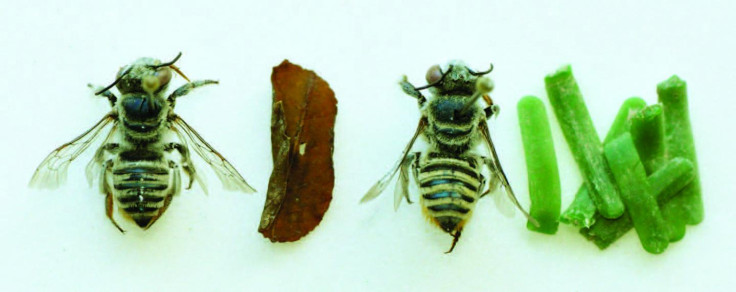Confused bees use green plastic instead of leaves to line nests
Bees adapting to abundance of plastic in environment but it's unlikely to lead to successful nests.

An elusive and little-studied species of leafcutter bee has been found to be cutting up bits of green plastic to line its nest instead of leaves.
The bee Megachile patellimana makes small nests in the ground and has evolved to cut sections of leaves with its jaws and carry them back to furnish the nest. Scientists have found bees adapting to an abundance of plastic in their environment by using it instead of leaves to line their nests, according to a paper published in the Journal of Hymenoptera Research.
The nest was found by following a leafcutter bee who was carrying a small piece of green plastic instead of a leaf back to her nest.
"In the nest of the female carrying plastic six more identical pieces of plastic were discovered grouped together in an apparent attempt to construct a cell. The cutting of the tough plastic would have been possible by using the large, robustly and acutely toothed mandibles," the authors write in the paper.
The nest was found in an irrigation furrow in the Dubai Desert Conservation Reserve. The plastic pieces had been cut from a larger sheet of the same green plastic, into strips measuring about 1cm long and 2mm wide. The dimensions and the use they had been put to in the nest showed that they were "clearly a substitute for leaves", the authors write.
However, the use of the plastic, while showing adaptability on the bee's part, is not likely to have led to a successful nest.
"As the pieces of plastic are stiff and narrow, they can't be wrapped around in the way the leaf pieces can be wrapped around to construct a cell," Sarah Kathleen Gess of Rhodes University told IBTimes UK. "And therefore it would be unlikely that the bee would be able to construct a cell."
The use of plastic by this leafcutter bee has not been observed before, but it adds to a list of bee species that have been adapting to a plastic-rich environment by using it to line nests.
The closely related bee Megachile rotundata (Fabricius) has been spotted previously cutting up pieces of polythene plastic bags to line its nest. In this case, Gess said, the bee was more successful in using plastic in its nest, as the polythene bag sections could be wrapped around and overlapped in a similar way to a leaf.
Another leafcutter bee, Megachile campanulae, which normally uses plant resins in its nest construction, has instead been spotted using polyurethane-based exterior building sealant.
© Copyright IBTimes 2025. All rights reserved.






















